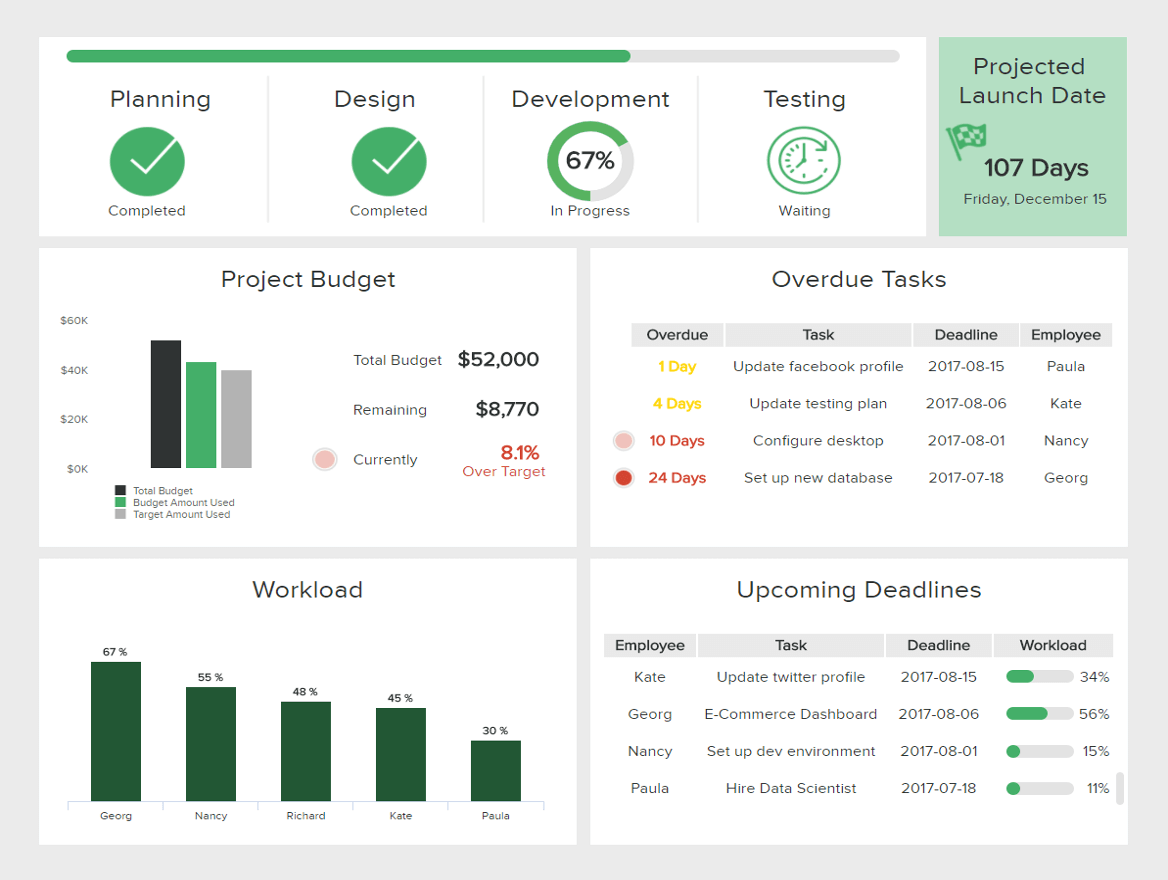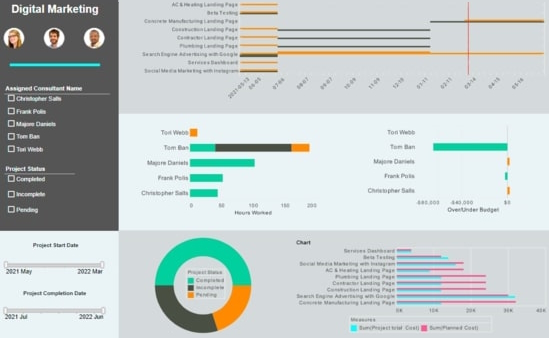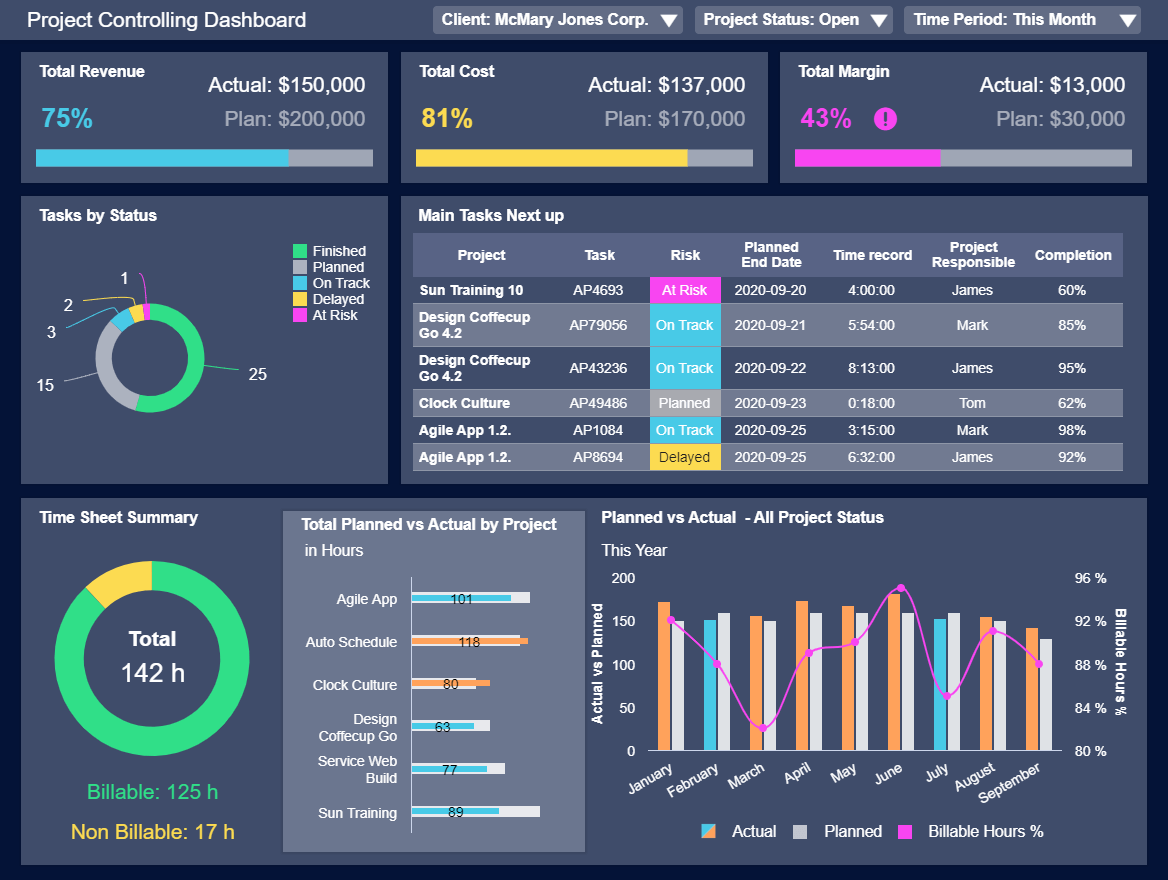Project Status Reporting Software
Effective project status reporting is essential for an organization's progress and should be implemented at all levels ranging from employees to owners and executives. The right status reporting software will make it easy to keep all of an organization's activities in check.
Project managers foremost need project progress and coordination information such as dashboards displaying Gantt charts (see dashboard example).
However, the dashboards and reports must be able to go beyond core project management data to give a holistic view of all factors that can impact on-time, on-budget delivery.
Benefits of Project Status Reporting with InetSoft
Project status reporting represents the critical reporting relationship between project managers and employees, as well as managers and executives. Using an agile status reporting tool such as InetSoft's Style Intelligence provides users an efficient platform to create reports and keep management updated on company and employee progress.
Project managers interact, share and collaborate with many parties. Visualization dashboards works excellently in most cases. Offline distributable reports become essential for many occasions where parties must share a large amount of information. InetSoft's pixel perfect, paginated document report engine is specifically desigend for these cases.
More About InetSoft's Project Status Reporting Software
Visualization dashboards are the most intutive ways to understand project information. However, not all dashboards are created equal. InetSoft's web app can easily connect to project management data to create self-service dashboards with rich built-in interactivity and customization.
For successfull delivery of projects, project managers must utilize all project related data, for example, supply chain and issue tracking system data. These systems are normally scattered. Some third party data may even be in Excel files. InetSoft's data mashup makes data processing a light-weight, business user self-serviceable process with great efficiency.

How a Damask Textile Manufacturer Switched from Teamwork.com to StyleBI
Damask, a centuries-old woven fabric known for its intricate patterns and luxurious finish, represents a niche market within the broader textile industry. Companies producing this fabric face unique project management challenges: coordinating skilled artisans, balancing small-batch production with high-end custom orders, and ensuring timely delivery to exclusive clients. For years, one mid-sized damask manufacturer relied on Teamwork.com to keep projects on track. However, as the business matured and its projects became more complex, the company recognized the need for a more powerful solution. Their transition to StyleBI for project status reporting reshaped not only their reporting workflows but also the way they aligned operations across departments.
The Nature of the Damask Industry
To appreciate the significance of this switch, it’s important to understand the damask industry itself. Unlike mass-market textiles, damask production is a blend of art and science. It requires specialized looms, detailed pattern design, and a keen eye for color and material quality. Projects can range from producing a bespoke run of fabrics for luxury hotels to crafting a one-of-a-kind pattern for a couture fashion house. Each order is treated as a project, complete with milestones for pattern design, loom setup, weaving, finishing, and delivery. Because customers are often high-profile or operate in demanding industries like interior design and fashion, project delays or missteps can have outsized consequences. For years, the company used Teamwork.com to manage timelines, assign tasks, and communicate with staff. While the software provided a solid foundation, it eventually fell short in reporting capabilities that could capture the intricacies of damask production cycles.
Limitations of Teamwork.com for Niche Manufacturing
Teamwork.com offered this company basic project tracking: Gantt charts, task assignments, and progress updates. However, damask projects aren’t as linear as typical product development projects. Production often involves reworking patterns, testing materials, and accommodating special client requests midstream. The company needed reporting that could go beyond task completion percentages. Executives wanted insights into how loom downtime affected delivery schedules, how much rework was cutting into profit margins, and whether the company was overcommitting resources during peak seasons. Teamwork.com’s reporting templates lacked the flexibility to mash up data from different departments—like finance, procurement, and operations—into a unified status report. Moreover, the company increasingly wanted to visualize historical data trends to predict bottlenecks before they occurred, something that was cumbersome within Teamwork’s ecosystem.
Why StyleBI Was the Right Fit
The decision to move to StyleBI was driven by its ability to deliver highly customizable project status reporting that extended well beyond the basics. StyleBI’s strength lies in its data mashup capabilities and its ability to integrate disparate sources of information into coherent dashboards. For the damask company, this meant that weaving schedules, procurement records for raw silk or linen, and financial tracking for each project could be visualized in one place. Managers no longer had to manually compile weekly reports across multiple systems. Instead, StyleBI pulled in data directly from production software, accounting tools, and scheduling applications, then layered those into dashboards that highlighted the real health of ongoing projects.
Perhaps most importantly, StyleBI gave the company predictive power. By analyzing data from past projects, the company could forecast delivery risks based on loom maintenance history, client change-request frequency, and seasonal order surges. This was something Teamwork.com simply wasn’t built to handle. The ability to pivot from reactive project management to proactive planning was a cultural shift for the damask manufacturer. Project managers now spent less time explaining delays and more time preventing them.
Improvements in Project Status Reporting
Before adopting StyleBI, the company’s project status reports were largely backward-looking. Managers would receive updates that confirmed what had already gone wrong. With StyleBI, reports became forward-looking and dynamic. Dashboards tracked schedule variance, resource utilization, and client request turnaround times in real time. Executives could drill into reports to see if a specific loom was responsible for multiple delays or if a particular client’s projects consistently pushed production timelines. This level of transparency allowed for more constructive conversations with both staff and customers.
The reporting also became more visually engaging. Rather than long lists of completed tasks, StyleBI enabled charts and heatmaps that highlighted risks. A red flag on a dashboard signaling loom downtime meant action could be taken immediately rather than after a weekly report review. In short, the project status reports evolved from static documents into living, breathing tools for decision-making.
Organizational and Cultural Impact
The shift to StyleBI didn’t just improve reports; it changed the way the company thought about projects altogether. Where Teamwork.com encouraged a narrow focus on tasks, StyleBI encouraged holistic thinking about outcomes. Project managers began to consider not only whether a fabric run was on time but also whether it was profitable and sustainable in the long term. Operations staff gained greater appreciation for how their day-to-day work affected delivery schedules and client satisfaction. Executives, for their part, finally had a way to connect the dots between financial performance and operational execution without sifting through multiple tools.
Clients also felt the impact. With more reliable reporting, the company could provide external stakeholders with status updates that were accurate and transparent. Luxury hotels commissioning custom fabrics appreciated the ability to see clear forecasts of delivery times, while fashion designers valued early warnings about potential supply issues. This boosted the company’s reputation for reliability in an industry where deadlines are often razor-thin.
The Future of Project Management in Niche Industries
This damask textile manufacturer’s journey highlights a broader trend: niche industries that once relied on generic project management tools are now demanding specialized reporting solutions. StyleBI, with its flexibility and data integration capabilities, is particularly well-suited for these industries where projects are complex, data is fragmented, and the stakes are high. For the damask company, the move away from Teamwork.com wasn’t a rejection of project management fundamentals—it was an acknowledgment that status reporting needs to evolve alongside business complexity. In a world where a delayed shipment of fabric can derail a fashion season or a hotel opening, advanced reporting is not a luxury but a necessity.
In the end, the company’s embrace of StyleBI transformed project status reporting from a bureaucratic obligation into a competitive advantage. It enabled the damask textile manufacturer not only to survive in a challenging industry but to thrive by blending tradition with modern data-driven insight. What began as a need for better reports became a foundation for smarter strategy, sharper execution, and stronger customer trust—proving that even the most obscure industries can benefit from a leap into the future of business intelligence.




